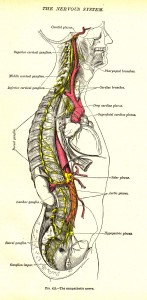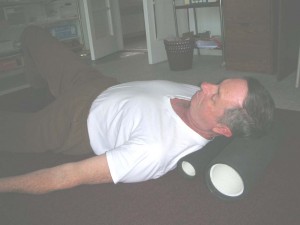There is a popular medical, pain management technique, called a ‘stellate ganglia block’, done with an injection of anesthesia into the upper thoracic and lower cervical area near the spine.
This seems to be a regular technique used for arm pain and maybe neck, head, and chest discomforts too. The stellate ganglia are part of the sympathetic nervous system and they come in pairs and lie on either side of the spine in the upper thoracic region. I often feel like  something is stuck in there and years ago I used to actually tear the skin over the upper thoracic vertebrae in an attempt to relieve the discomfort I was feeling there. I am a lot more gentle and careful now. I did have someone do a drawing that illustrated my discomfort in this region and this is it. I felt pierced and wounded, as if by an arrow stuck in my upper back. I felt like I was carrying a weight on my shoulders.
something is stuck in there and years ago I used to actually tear the skin over the upper thoracic vertebrae in an attempt to relieve the discomfort I was feeling there. I am a lot more gentle and careful now. I did have someone do a drawing that illustrated my discomfort in this region and this is it. I felt pierced and wounded, as if by an arrow stuck in my upper back. I felt like I was carrying a weight on my shoulders.
 Here’s a color drawing of the sympathetic nerve. The inferior cervical ganglia are also called the stellate ganglia maybe because they have so many branches reaching out in many directions affecting a large area of the upper body.
Here’s a color drawing of the sympathetic nerve. The inferior cervical ganglia are also called the stellate ganglia maybe because they have so many branches reaching out in many directions affecting a large area of the upper body.
Stellate ganglia (inferior cervical ganglia)________________
 Now I use a two-roller technique with a small roller placed in the upper thoracic area, delivering the manipulation, and a large roller supporting my head. The action is a prying open of the space between the first and second thoracic vertebrae. This helps tone down the sympathetic nerves and specifically the stellate (lower cervical) ganglia. These nerves deliver the stress, tension, strain, and distortion message to the body. Open up this upper thoracic area and we go a long ways towards relieving arm, neck, head, and chest discomforts and strains.
Now I use a two-roller technique with a small roller placed in the upper thoracic area, delivering the manipulation, and a large roller supporting my head. The action is a prying open of the space between the first and second thoracic vertebrae. This helps tone down the sympathetic nerves and specifically the stellate (lower cervical) ganglia. These nerves deliver the stress, tension, strain, and distortion message to the body. Open up this upper thoracic area and we go a long ways towards relieving arm, neck, head, and chest discomforts and strains. The sympathetic nerve ganglia are in pairs and lie on either side of the spine. Leaning to one side or the other, and then pressing into the spine, effectively helps release these stress and tension inducing ganglia, muting their stress and tension producing actions. A small roller might be more effective than a large one, in this upper thoracic region, because it can focus more sharply between these vertebrae.
The sympathetic nerve ganglia are in pairs and lie on either side of the spine. Leaning to one side or the other, and then pressing into the spine, effectively helps release these stress and tension inducing ganglia, muting their stress and tension producing actions. A small roller might be more effective than a large one, in this upper thoracic region, because it can focus more sharply between these vertebrae.